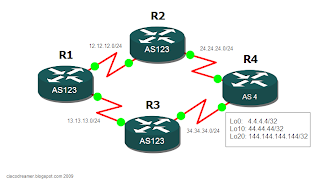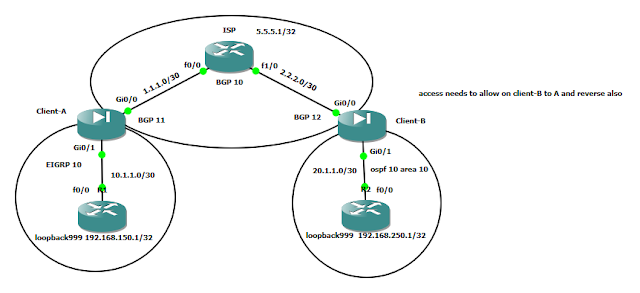BGP Local Preference
Local Preference is one of the ways to alter the path taken by one AS to reach another AS. The difference between Local Preference and Weight is that Weight is just locally signifant in the router while Local Preference is what I call "Local AS significant". What I mean by that is that Local Preference is being propagated Intra AS but not outside the AS.
Local preference is to influence your own AS how to get or exit to another AS.
MED is to influence other AS how to enter your AS.
The higher the local preference, the more preferred.In this lab, local preference will be configured and will be using route map for more flexibility. Check the diagram below for details.

R1, R2 and R3 belongs to AS 123. R4 is in AS4 and is advertising 4.4.4.4/32, 44.44.44.44/32 and 144.144.144.144/32 subnets.We need to set all routes learned from R3 to have local preference value of 300. After which, configure a route-map that will assign a local preference of 500 in R2 for the network 144.144.144.144/32.
Here are the initial BGP configurations on the routers.
R1# ! router bgp 123 no synchronization bgp log-neighbor-changes neighbor 12.12.12.2 remote-as 123 neighbor 13.13.13.3 remote-as 123 no auto-summary R2# ! router bgp 123 no synchronization bgp log-neighbor-changes neighbor 12.12.12.1 remote-as 123 neighbor 12.12.12.1 next-hop-self neighbor 24.24.24.4 remote-as 4 no auto-summary R3# ! router bgp 123 no synchronization bgp log-neighbor-changes neighbor 13.13.13.1 remote-as 123 neighbor 13.13.13.1 next-hop-self neighbor 34.34.34.4 remote-as 4 no auto-summary R4# ! router bgp 4 no synchronization bgp log-neighbor-changes network 4.4.4.4 mask 255.255.255.255 network 44.44.44.44 mask 255.255.255.255 network 144.144.144.144 mask 255.255.255.255 neighbor 24.24.24.2 remote-as 123 neighbor 34.34.34.3 remote-as 123 no auto-summary
Let's see what is the best path taken by R1 to reach the networks advertised by R4.
R1#sh ip bgp BGP table version is 10, local router ID is 1.1.1.1 Status codes: s suppressed, d damped, h history, * valid, > best, i - internal, r RIB-failure, S Stale Origin codes: i - IGP, e - EGP, ? - incomplete Network Next Hop Metric LocPrf Weight Path *>i4.4.4.4/32 12.12.12.2 0 100 0 4 i * i 13.13.13.3 0 100 0 4 i *>i44.44.44.44/32 12.12.12.2 0 100 0 4 i * i 13.13.13.3 0 100 0 4 i *>i144.144.144.144/32 12.12.12.2 0 100 0 4 i * i 13.13.13.3 0 100 0 4 i R1#sh ip route | beg Gateway Gateway of last resort is not set 1.0.0.0/32 is subnetted, 1 subnets C 1.1.1.1 is directly connected, Loopback0 4.0.0.0/32 is subnetted, 1 subnets B 4.4.4.4 [200/0] via 12.12.12.2, 00:04:00 144.144.0.0/32 is subnetted, 1 subnets B 144.144.144.144 [200/0] via 12.12.12.2, 00:04:00 12.0.0.0/24 is subnetted, 1 subnets C 12.12.12.0 is directly connected, Serial1/2 13.0.0.0/24 is subnetted, 1 subnets C 13.13.13.0 is directly connected, Serial1/3 44.0.0.0/32 is subnetted, 1 subnets B 44.44.44.44 [200/0] via 12.12.12.2, 00:04:00
It's clear that it prefers to take R2 to reach the networks in R4. Let's configure R3 so that all routes received by R3 will have a Local preference of 300
R3#config t R3(config)#router bgp 123 R3(config-router)#bgp default local-preference 300 R1#sh ip bgp BGP table version is 13, local router ID is 1.1.1.1 Status codes: s suppressed, d damped, h history, * valid, > best, i - internal, r RIB-failure, S Stale Origin codes: i - IGP, e - EGP, ? - incomplete Network Next Hop Metric LocPrf Weight Path * i4.4.4.4/32 12.12.12.2 0 100 0 4 i *>i 13.13.13.3 0 300 0 4 i * i44.44.44.44/32 12.12.12.2 0 100 0 4 i *>i 13.13.13.3 0 300 0 4 i * i144.144.144.144/32 12.12.12.2 0 100 0 4 i *>i 13.13.13.3 0 300 0 4 i
Immediately, even without clearing the BGP process, R3 now became the more preferred path to reach R4. Remember that in Local Preference, the higher the value, the more preferred.
Let's configure in R2 a route-map so the network 144.144.144.144/32 will have a local preference of 500. This will make R2 the best path to reach the mentioned network.
R2(config)#access-list 1 permit host 144.144.144.144 R2(config)#route-map LOCALPREF500 permit 10 R2(config-route-map)#match ip address 1 R2(config-route-map)#set local-preference 500 R2#(config)# router bgp 123 R2(config-router)#neighbor 24.24.24.4 route-map LOCALPREF500 in R2# clear ip bgp * R1#sh ip bgp BGP table version is 14, local router ID is 1.1.1.1 Status codes: s suppressed, d damped, h history, * valid, > best, i - internal, r RIB-failure, S Stale Origin codes: i - IGP, e - EGP, ? - incomplete Network Next Hop Metric LocPrf Weight Path *>i4.4.4.4/32 13.13.13.3 0 300 0 4 i *>i44.44.44.44/32 13.13.13.3 0 300 0 4 i *>i144.144.144.144/32 12.12.12.2 0 500 0 4 i * i 13.13.13.3 0 300 0 4 i
Firstly, why is that the route-map has an "in" direction. It's because we are receiving the route from another router, R2 is not the one advertising. You can see now that path to 144.144.144.144/32 will have R2 as the next hop. If you noticed also, why is that for 4.4.4.4/32 and 44.44.44.44/32, there is no other path except through 13.13.13.3. Check the route-map above and you'll find the answer. There is no succedding line after line 10, which means, it will block out the subnets and not advertised it to R1.
Let's configure the 20th sequence of the route-map.
R2(config)#route-map LOCALPREF500 permit 20Let's see now if there are changes.
R1#sh ip bgp BGP table version is 16, local router ID is 1.1.1.1 Status codes: s suppressed, d damped, h history, * valid, > best, i - internal, r RIB-failure, S Stale Origin codes: i - IGP, e - EGP, ? - incomplete Network Next Hop Metric LocPrf Weight Path * i4.4.4.4/32 12.12.12.2 0 100 0 4 i *>i 13.13.13.3 0 300 0 4 i * i44.44.44.44/32 12.12.12.2 0 100 0 4 i *>i 13.13.13.3 0 300 0 4 i *>i144.144.144.144/32 12.12.12.2 0 500 0 4 i * i 13.13.13.3 0 300 0 4 i

Comments
Post a Comment